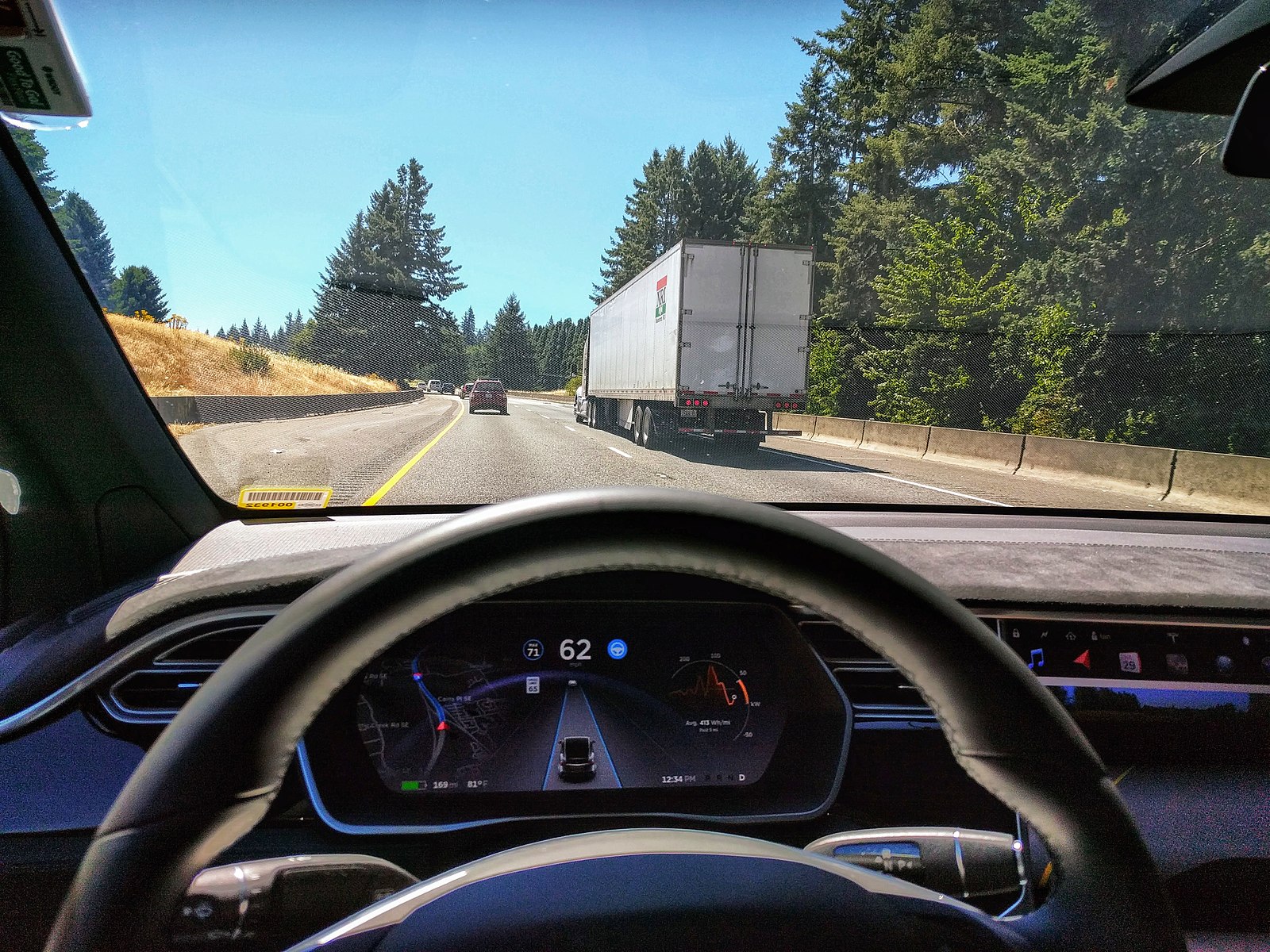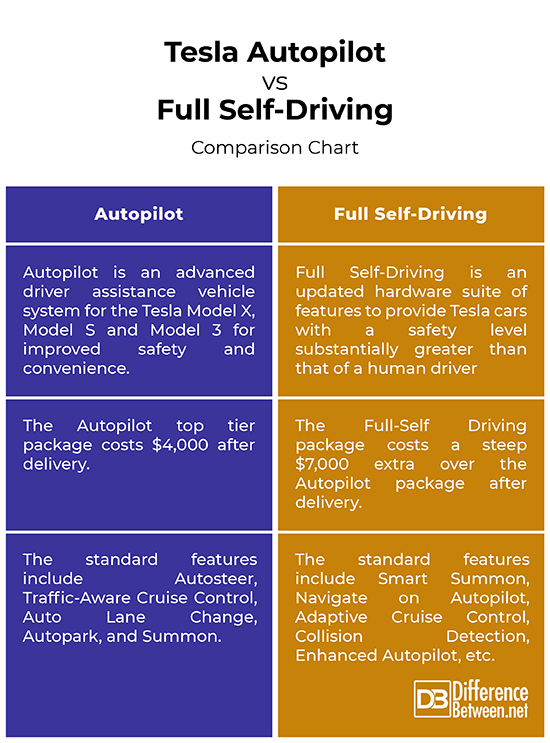Difference Between Autopilot and Full Self-Driving
Tesla Motors and its visionary CEO Elon Musk shook up the staid auto industry by creating a set of self-driving electric vehicles that redefined the auto marketplace and defied conventional wisdom. Tesla is defining the future of the industry. Although, the idea of autonomous cars started way before Elon Musk and Tesla cars, Tesla autopilot-equipped cars are the closest anyone had ever come to bring autonomy in vehicles. For the first time in hundreds of years, we are in the middle of a major transformation in the auto industry. Thanks to Tesla, we are now transitioning to mobility services based on electric-powered and driverless vehicles. In fact, Tesla has a fleet of nearly 800,000 vehicles equipped with autopilot features on the road and they are planning to bring full self-driving capabilities in the future.

What is Tesla Autopilot?
In 2014, the International Society of Automotive Engineers developed a six-level classification system for automation as: (Level 0) no automation, (Level 1) driver assistance, (Level 2) partial driving automation, (Level 3) conditional automation, (Level 4) high driving automation, and (Level 5) full driving automation.
Autopilot is a semi-autonomous feature offered by Tesla and is classified as a Level 2 automated system to enhance safety and convenience behind the wheel. Autopilot features were first introduced to Tesla owners in Oct 2015 via a free over-the-air software update. The Autopilot feature has the ability to temporarily control the car’s powertrain, brake and steering under specific highway conditions. The standard Autopilot features offered by Tesla include Autosteer and Traffic-Aware Cruise Control, Auto Lane Change, Autopark, and Summon. It reduces the driver’s workload as a driver and uses a combination of a camera and radar with enhanced processing, 12 ultrasonic sensors to improve the functionality of your Tesla car, while making it safer and more capable. However, it does not make the vehicle completely autonomous and in fact, requires driver to be in total control all the time.

What is Tesla Full Self-Driving?
The full self-driving capability is one of the Autopilot packages available for purchase. In 2016, Tesla announced that all of its vehicles in production along with the upcoming Model 3 will come pre-built with an updated hardware suite, which will offer full self-driving capability to Tesla cars at a safety level substantially greater than that of a human driver. Like the Autopilot feature, the full self-driving capability requires active driver supervision with hands on the wheel at all times and the driver ready to take over at any moment. Eight surround cameras provide 36-degree coverage around the vehicle at up to 250 meters and 12 updated ultrasonic sensors provide improved safety, allowing for both hard and soft objects detection at nearly twice the distance of the prior system. It has been developed to automate vehicle systems for safety and better drivability.
Difference between Tesla Autopilot and Full Self-Driving
Autonomy
– Both are semi-autonomous vehicle systems offered by Tesla to provide improved safety and better drivability. Both Autopilot and Full Self-Driving are Autopilot packages available for purchase and are classified as semi-autonomous vehicle systems. Autopilot is classified as a Level 2 autonomous system as described by the International Society of Automotive Engineers which is considered a driver assistance feature with driver responsible for being in control of the vehicle at all times. The Full Self-Driving capability promises to deliver intelligent performance with active driver supervision required at all times at a future time.
Features
–The standard Autopilot features could allow your vehicle to detect obstacles and lane markings, autosteer, drive, use the brakes, and manage speed during highway driving, and self-park in perpendicular positions. The Full Self-Driving capability is designed to provide additional features for enhanced drivability and improved safety on road. The standard features include collision detection, adaptive cruise control, auto braking and steering, navigate to Autopilot, auto parking in both perpendicular and parallel spaces, and Smart Summon, which allows you to move your car in and out of a parking space with the mobile app or the key.
Cost
– The lower Autopilot tier costs $3,000 when added at the time of purchase of Model X, Model S or Model 3. When added to your vehicle after delivery, it will cost $4,000 if purchased on or after Feb 28, 2019. Tesla sells the Full Self-Driving package at a steep $7,000 after delivery on top of the cost of the Autopilot, which is an additional $1,000 increase from the previous $6,000 after Tesla bundled some features of the Autopilot into the package. The value of the technology along with all the necessary upgrades would be over $100,000.
Tesla Autopilot vs. Full Self-Driving: Comparison Chart

Summary of Tesla Autopilot vs. Full Self-Driving
While the features in both the Autopilot and Full Self-Driving package are designed to make your vehicle more capable and intelligent with human supervision, they do not make your vehicle fully autonomous. In fact, the driver is always in complete control of the vehicle and must be ready to take control of the vehicle at any moment. In 2019, Tesla updated its Autopilot suite and replaced the ‘Enhanced Autopilot’ suite with ‘Autopilot’ feature with significant changes in features and pricing. The full potential of the Full Self-Driving capability is still a work in progress and Tesla will further calibrate the new package using millions of miles of real-world driving. However, the full autonomy in vehicles is still a long way to go.
- Difference Between Caucus and Primary - June 18, 2024
- Difference Between PPO and POS - May 30, 2024
- Difference Between RFID and NFC - May 28, 2024
Search DifferenceBetween.net :
Leave a Response
References :
[0]Denton, Tom. Automobile Electrical and Electronic Systems. Abingdon, United Kingdom: Routledge, 2017. Print
[1]Denton, Tom. Automobile Electrical and Electronic Systems. Abingdon, United Kingdom: Routledge, 2017. Print
[2]Harris, Don. Engineering Psychology and Cognitive Ergonomics: Cognition and Design: 14th International Conference, EPCE 2017, Held as Part of HCI International 2017, Vancouver, BC, Canada, July 9-14, 2017, Proceedings, Part II. Berlin, Germany: Springer, 2017. Print
[3]Lim, Hannah YeeFen. Autonomous Vehicles and the Law: Technology, Algorithms and Ethics. Cheltenham, United Kingdom: Edward Elgar Publishing, 2018. Print
[4]Burns, Lawrence D. and Christopher Shulgan. Autonomy: The Quest to Build the Driverless Car—And How It Will Reshape Our World. NYC, United States: HarperCollins, 2018. Print
[5]Image rcedit: https://upload.wikimedia.org/wikipedia/commons/8/8a/Silver_and_Midnight_Silver_Tesla_Model_3s.jpg
[6]Image credit: https://commons.wikimedia.org/wiki/File:Tesla_Autopilot_Engaged_in_Model_X.jpg
